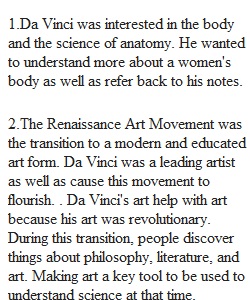


Q Discussion Board- Leonardo da Vinci Before you begin the assignment, read the following Discussion Board Directions. The directions state the requirements for this and all other discussion boards. Our discussion board welcomes all voices to the forum to create an inclusive sense of community and foster the development of trust and respect. COMMON COURTESY: All students must follow the rules of common courtesy in all email messages and discussion posts. Any inappropriate or offensive correspondence will be forwarded to online administrators and forwarded to Student Affairs. All posts are due on Saturday at midnight. The weekly discussion board will be closed at midnight on Saturday. If you do not post by Saturday at midnight you will not receive a grade for that week. If you post only once you will receive a maximum grade of 80 out of 100. Each student must contribute to the class discussion board to receive a grade. Students must make one initial post answering the questions and at least 1 follow-up post about another student’s post. Use at least 100 words or more for your post. When requested you are to include examples and provide detailed visual evidence for any claim or argument that you make. Strive for thoughtfulness and nuance. In your follow-up post bring a new idea to the discussion. Stating “John that was a great post”, is an insufficient response and will receive no points. Respond to this post. REMEMBER YOU MUST MAKE at least 1 POST and 1 response to get full credit! All students should make their first post early so other students have time to reply to posts. Answer the discussion by numbering your answers with the question numbers. Do not answer discussions by email. Email responses will not be graded. All images must be embedded into the discussion board. See directions in Definitions Module. Intersection of Art and Science “Study the science of art. Study the art of science. Develop your senses – learn how to see. Realize that everything connects to everything else.” — Leonardo da Vinci (Green, 2018) History has seen many parallels between art and science. Nearly opposite in nature, Art is the imaginative flow of the conscious while science is the methodical outlook on reality. Leonardo da Vinci is one of the artists who had mastered both. His work illustrates the world by transcending and merging the sub-conscious and the real world. His goal was to understand visual reality and the components or parts that make up the whole. • Find a drawing by Leonardo da Vinci depicting scientific discoveries • Embed the image with the artist's name and title of artwork. • Use the numbers used for questions when answering the questions. • Do not write the questions in your answers. • Use a minimum of 100 words or more for your post • Reply to another students' post Leonardo da Vinci's drawings bridge the divide between science and art. Add image. 1. Explain how your image reflects da Vinci's understanding and interest in art and science. 2. Define the Renaissance Art Movement and Di Vinci's importance in the movement. 3. How did the Renaissance change the view of science from the view during the Dark Ages? 3. Why was the artist's drawing a "revolutionary" idea during the Renaissance? 4. Give an example of the merger of art and science today? How is that merger important?
View Related Questions